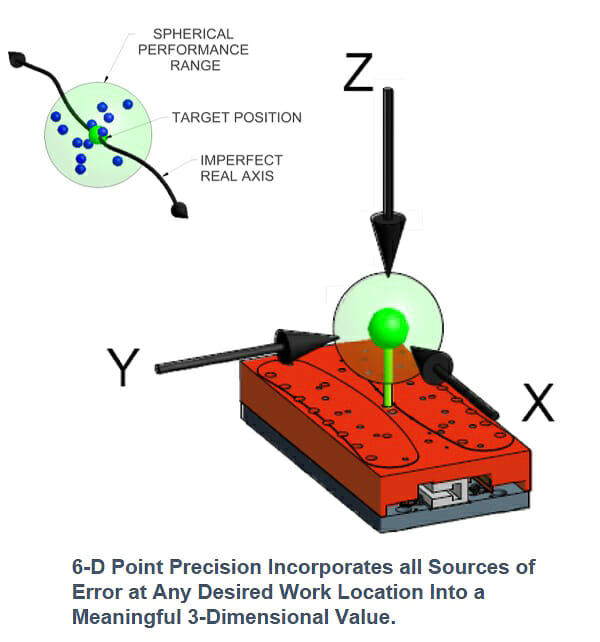(Arvada, CO, USA, January 2022) It was recently announced that the draft of the ASME B5.64 standard “Methods for the Performance Evaluation of Single Axis Linear Positioning Systems” has been completed and passed to the ASME for balloting. For ALIO, an Allied Motion Company, this is a significant milestone, as it demonstrates industry recognition a new method for defining the precision of advanced motion control solutions, which is consistent with the suggestions made by ALIO over the last 15 years.
Bill Hennessey, President of ALIO stated, “The language used by suppliers of technology solutions aimed at precision engineering applications has for a long time been vague and, in some instances, confusing. ALIO is a provider of the some of the most accurate and repeatable motion control solutions available in the market today and has always found itself constrained by the use of traditional language and words such as ‘precision’ and ‘resolution’, which without any degree of qualification are basically meaningless. When analyzing motion control solutions that provide sub-micron and nanometer-level accuracy, ALIO contended that a new language was necessary, and new standards were required to indicate the real levels of precision that different motion control solutions can achieve. With this in mind, over 10 years ago ALIO trademarked the phrases Point Precision® and 6D Point Precision® to protect our position in the market. Today, with the publication of the ASME B5.64 standard, we take great pride that our efforts to redefine the way precision motion control solutions are measured have been recognized in a very positive manner. This is ultimately of enormous benefit for end-users who will now be able to specify solutions that can truly achieve what they need in respect of precision and repeatability. Given that ALIO has effectively been operating within the guidelines of the new recommended standards over the last 15 years, and with the combined global reach alongside Allied Motion, we believe we are well positioned to be a leader in the global nano-positioning market.”
All motion systems operate in 3-dimensional space and have errors in 6 degrees of freedom (6-DOF). However, motion systems are often only characterized by performance data of a single or subset of these 6-DOF. This practice leaves several error sources unaccounted for in performance data and specifications. For more than 15 years, ALIO has contended that repeatability performance for metrology inspection and manufacturing systems must be analyzed and specified using a “point repeatability” method that accounts for 6D spatial errors in order to provide true representation of nanometer-precision performance. This is now an area that the ASME B5.64 standard has highlighted as important.
Hennessey continues, “Many traditional stage and motion systems specify repeatability as a single number representing the variation in linear displacement along an axis of travel, i.e. plane repeatability. Historically, this practice was valid as the repeatability specifications were large enough that other error factors were only a small percentage of the total error and could be ignored. The repeatability of the plane position along the axis is effectively measured over many cycles at a target position. The intersections of this plane with the axis is a point on the axis line and the collection of these points results in 1D repeatability performance.”
This test method makes a critical assumption, namely that the plane only moves in one dimension and the axis is perfectly straight. At the nanometer-level, this assumption is not realistic. In nanometer-level precision systems, “other” errors that were previously ignored in less accurate systems often become equal to or greater contributors to the 6D repeatability performance. At the nanometer-level, the axis of travel should actually be shown as bending and twisting through three-dimensional space and thus plane visualization becomes meaningless as it will tip, tilt, and twist as the stage moves along the axis. The stage moves in 6D space, therefore neglecting these additional error sources can result in a misrepresentation of actual stage repeatability performance.
Each linear (or angular) direction the stage moves (or rotates) in results in a positional error in that direction. That motion, which must not be neglected when nanometer-precision is desired, will have an associated repeatability of that error motion. Each point on a stage mounting surface will move in 3D space as of a result of this error motion in 6-DOF. It is the point repeatability of an infinite number of points attached to a stage that must be characterized by testing and specification data. Thus, each point repeatability will result in a spherical repeatability range.
Hennessey concludes, “To accurately characterize repeatability, X, Y, and Z components must be measured in a systematic process to characterize the point repeatability of a stage along the entire axis. Additionally, a process must be implemented to test the influence of pitch, yaw, and roll errors of the axis and their influence on repeatability. To have a high confidence in integrated system performance, the motion subsystems must be correctly characterized for 6D performance accounting for all error components of stage motion. At ALIO we have been producing motion control solutions for our customers for 15 years with precision claims being made in line with the exacting requirements of Point Precision® and 6D Point Precision®, and for the benefit of users of such cutting-edge motion control solutions it is extremely encouraging that via the ASME B5.64 standard, users will now be able to assess the real levels of precision and repeatability that alternative motion control solutions offer.”








